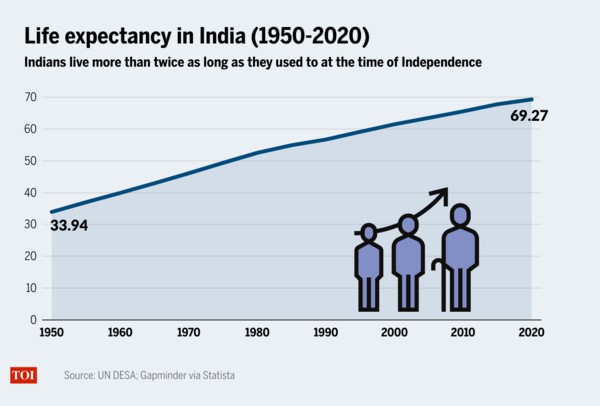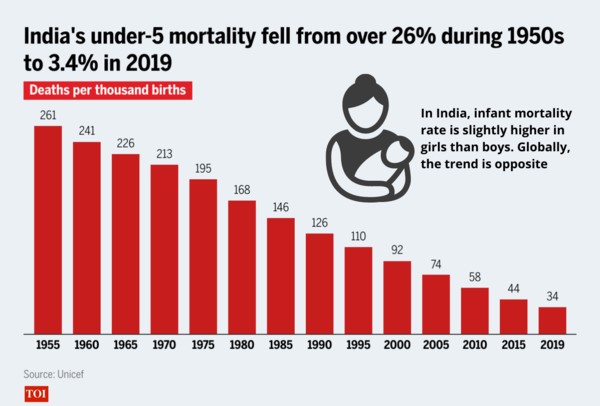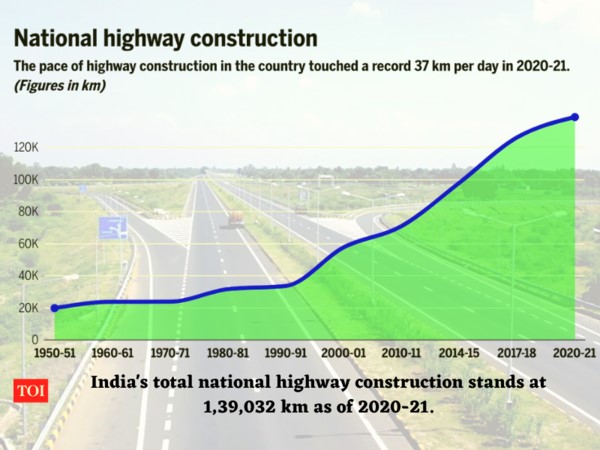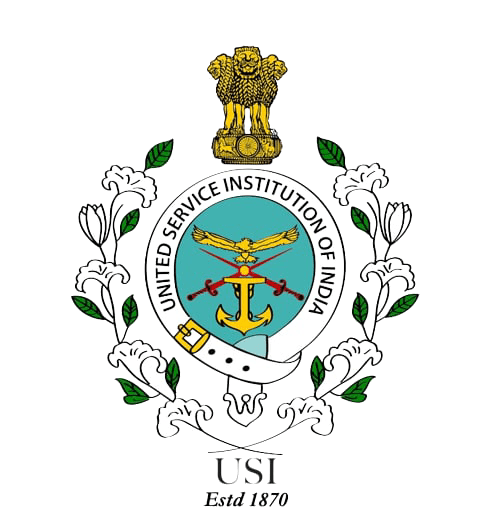Azadi Ka Amrit Mahotsav is an initiative of the Government of India to celebrate and commemorate 75 years of independence and the glorious history of its people, culture and achievements. This Mahotsav is dedicated to the people of India who have not only been instrumental in bringing India thus far in its evolutionary journey but also hold within them the power and potential to enable Prime Minister Narendra Modi’s vision of activating India 2.0, fuelled by the spirit of Aatmanirbhar Bharat. The official journey of Azadi Ka Amrit Mahotsav commenced on 12 March 2021 which started a 75-week countdown to our 75th anniversary of independence and will end post a year on 15 August 2023. Following are the five themes of Azadi Ka Amrit Mahotsav.
Assessing India’s Journey
How should we assess India’s record as an independent country over the 75 years since Independence? The most obvious point is that it has marked a dramatic departure from the preceding 90 years of colonial rule, and the century of exploitative colonial capture before that. Since 1947, India has achieved tremendous progress in raising economic and social growth. Here’s an overview of how far our nation has come today.

India’s GDP 1960-2020
Since 1947, India has achieved tremendous progress in raising growth, income levels and standards of living. The gross domestic product (GDP) increased from Rs 2,939 billion during 1950-51 to Rs 56,330 billion during 2011-12 (2004-05 constant prices). In 2018-19, India’s GDP was valued at an estimated Rs 1,40,776 billion (2011-12 constant prices).
At the same time, the average Indian citizen earned an income of just around Rs 7,513 during 1950-51, which increased to Rs 41,255 during 2011-12 (2004-05 constant prices) and further to Rs 92,565 during 2018-19 (2011-12 constant prices). The per capita income increased in real terms despite a significant increase in the population of the country.[i]

Life Expectancy in India 1950-2020
In the last 75 years, India has improved tremendously with respect to life expectancy. In 1947, the expectancy of an average Indian citizen was around 32 years and it has increased to 70.19 years in 2022. The increase in life expectancy in the last 75 years has been over 100 percent.[ii]

India’s Under -5 Mortality Rate
According to United Nation projections, India’s current infant mortality rate in 2022 is 27.695 deaths per 1000 live births, a 3.74 percent decline from 2021. The findings of the National Health Family Survey-5 (NHFS-5) revealed that IMR has marginally declined in nearly all states and Assam has seen one of the largest drops in IMR, from 48 deaths (per 1,000 live births) to 32 deaths. Meanwhile, in the 1940s, the Maternal Mortality Ratio (MMR) was 2000/100,000 live births, which apparently came down to 1000 in the 1950s. Moreover, India is also a signatory to the United Nations (UN) Sustainable Development Goals (SDGs), which adopted a global MMR target of fewer than 70 deaths per 100 000 live births by 2030. In March this year, a special bulletin by the Registrar General of India was released which claims that the MMR has declined by 10 points. It has declined from 113 in 2016-18 to 103 in 2017-19 which is an 8.8 percent decline.[iii]

National Highway Construction 1950-2020
As per figures, the total length of National Highways (NHs) in 1947, when India attained independence, was about 21,378 km, which has now gone up to more than 1.40 lakh km. India now has second largest road networks in the world with a total length of about 62 lakh km. Road transport accounts for about 87% of passenger traffic and 60% of freight traffic movement. National highways are a very important constituent of the road network in India. Though it comprises 2.3% of total road network, it carries about 40% of the road traffic.[iv]
‘Har Ghar Tiranga’ campaign
A brainchild of Prime Minister Narendra Modi, Har Ghar Tiranga is a campaign under the backing of Azadi Ka Amrit Mahotsav. The campaign aims at encouraging people to bring the Tiranga or tricolour home and to hoist it to mark the 75th year of India’s independence.
PM Modi has requested all the countrymen to hoist the national flag in their homes as a part of the Har Ghar Tiranga initiative (every house should hoist the tricolour flag). Besides, the prime minister has also urged people to change the display pictures of their social media accounts – Facebook, Twitter, and Instagram – to the Tiranga or tricolour.
The countrymen can express their enthusiasm and commitment by hoisting a flag at their houses from 13 to 15 August 2022. “Our relationship with the flag has always been more formal and institutional than personal. Bringing the flag home collectively as a nation in the 75th year of independence thus becomes symbolic of not only an act of personal connection to the Tiranga but also an embodiment of our commitment to nation-building. The idea behind the initiative is to invoke the feeling of patriotism in the hearts of the people and to promote awareness about the Indian National Flag,” the Ministry of Culture said.
People have been using ‘Tiranga’ as a display picture on their social media accounts between 2 and 15 August to commemorate the 75th anniversary of India’s Independence.
Earlier this month, Union Home Minister Amit Shah said the “Har Ghar Tiranga” programme is a message to the world that every citizen of India is united to take forward India’s journey of development, prosperity, security and culture.
Conclusion
India’s GDP has increased from 2.7 lac crore in 1947 to 147.79 lac crore today – India has become the fifth largest economy but India’s GDP per capita at less than USD 2000 puts India under a struggling LMIC – Lower Middle-Income Country.[v]
India has become the fastest growing economy but our national debt increased to a whooping 91 lac crore.[vi]
India has become a nuclear power but still a percentage of Indians lives without electricity and water.[vii]
India’s literacy rate increased from about 12 percent in 1947 to 74 percent, but employability is still a major challenge.[viii]
In 75 years, Indian democracy has come a long way. India’s stature before the world has also grown and we are being looked up as a ‘potential super-power’ and we can be described aptly as a hope for the world at this stage. But, we still have a long way to go, and we have to recognise that we are still a ‘developing country’ and that too, in the middle rung of LMICs.
Endnotes
[i] The Evolution of the Indian Economy since Independence
https://www.ciiblog.in/the-evolution-of-the-indian-economy-since-independence/
[ii] India at 75: Important healthcare achievement of the country since gaining independence
https://www.financialexpress.com/healthcare/news-healthcare/india-at-75-important-healthcare-achievement-of-the-country-since-gaining-independence/2621945/
[iii] India at 75: Important healthcare achievement of the country since gaining independence
[iv]India now has 2nd largest road network in the world
75-YEAR JOURNEY OF TRANSPORT SECTOR & MORTH
[v] India @ 75: A Hope for the World
https://www.outlookindia.com/website/story/india news-india-75-a-hope-for-the-world/391406
[vi] ibid
[vii] ibid
[viii] Ibid
Dr Jyoti Yadav holds Phd in Public Policy and her interest areas include Legislative Research and International Relations.
Article uploaded : 13-08-2022
Disclaimer : The views expressed are those of the author and do not necessarily represent the views of the organisation that he/she belongs to or of the USI of India.
